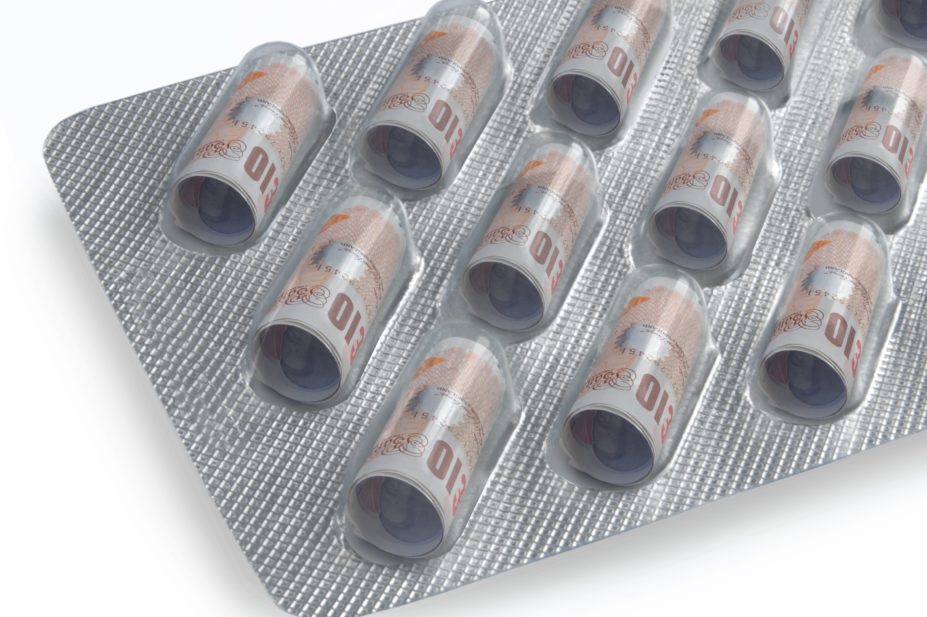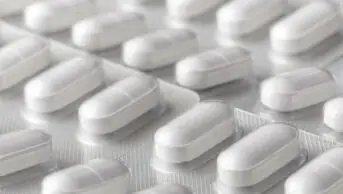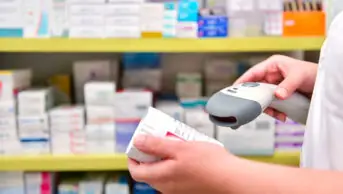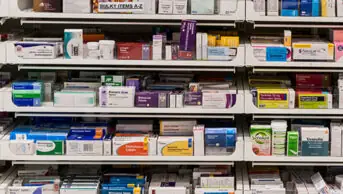
Shutterstock.com
The generic medicines market has long been touted as a money saver for the NHS on a drugs bill that has risen relentlessly for 15 years.
Although £18.9bn was the cost of all NHS medicines dispensed in hospitals and in the community in 2018–2019 — an 84% increase on the 2005 cost of £10.3bn — the NHS Business Services Authority highlights the “significant savings for the NHS” generated by the 81% of drugs in primary care that are prescribed generically in England.
This may be true for some generic medicines, but an analysis by The Pharmaceutical Journal of drug tariff prices for Category A generic medicines has revealed a more disturbing trend.
Category A drug prices currently encounter no government controls, unlike the prices of Category M drugs, which are adjusted quarterly by the government to control distribution of the £800m medicines margin. But Category A includes commonly used drugs such as paracetamol 250mg/5mL oral suspension and tamsulosin 400 microgram modified-release capsules.
In July 2018, legislation was introduced that would allow the government to challenge “unwarranted” prices of all generic drugs, but it has yet to be used.
Figures analysed by The Pharmaceutical Journal reveal that, far from making savings, the NHS has paid an additional £76m in the past two years (see Box 1), with 33 Category A products seeing their prices more than double between July 2018 and October 2020.
Overall, 351 Category A medicines saw their prices increase in that time, while 76 Category A medicines decreased in price and the price of 212 medicines stayed the same.
Tariff prices for Category A medicines are calculated based on their list price at two wholesalers, AAH and Alliance Healthcare (Distribution) Ltd, and two manufacturers, Teva UK and Accord, in a weighted formula.
This means that Category A medicines are more prone to market dominance, as the weighted formula allows the medicine to be available from just one manufacturer in addition to the two wholesalers.
In some cases, we have seen an increase in price for products that have no competition
“In some cases, we have seen an increase in price for products that have no competition, and we have referred a number of these to the Competition and Markets Authority [CMA],” a Department of Health and Social Care spokesperson says.
And they add that the NHS relies on competition to drive down prices of Category A medicines, “which has led to some of the lowest prices in Europe”.
The CMA is currently conducting investigations into the pricing of just four Category A drugs: hydrocortisone, nitrofurantoin, phenytoin and lithium-based drugs.
Of the 33 Category A medicines that have seen significant price rises, packs of 28 risperidone 6mg tablets have seen the largest increase, skyrocketing from £2.68 to £49.21 per pack — an increase of 1,736%.
And this can cause problems. Ciara Ni Dhubhlaing, president of the College of Mental Health Pharmacy, labelled this a “huge increase” despite being an uncommon dose.
“There are other strengths available, which may be more economical; e.g. 2mg x 3 tablets, or a 4mg tablet and a 2mg tablet,” says Ni Dhubhlaing. “But it is usually best to keep the tablet burden as low as possible for patients and to avoid mixing strengths in case of confusion.”
Any price increase is a particular concern when health services are under immense financial pressure
She adds that “any price increase is a particular concern in these times, when health services are under immense financial pressure to fund treatments and, hopefully, vaccines for COVID-19”.
David Taylor, director of pharmacy and pathology at South London and Maudsley NHS Foundation Trust, also says that “cheap 4mg and 2mg tablets” would be used to make up a 6mg dose of risperidone.
But he adds that the trust does “have trouble with phenelzine, tranylcypromine and aripiprazole, as their cost varies substantially” each month.
The price of tranylcypromine 10mg has increased by 45% in two years, while aripiprazole 30mg tablets has seen its price increase by 31%. Both of these are Category A medicines.
Two strengths of Category A salbutamol nebuliser liquid — 2.5mg/2.5mL and 5mg/2.5mL — have also seen their prices increase, by 108% and 65% respectively.
Salbutamol nebuliser liquid is currently on the list of medicines that cannot be parallel exported because “the export of that medicine is either contributing to, or may contribute to, a shortage of that medicine in the UK”.
Two of the three products that have seen the highest increases were manufactured by the generics arm of a manufacturer now under investigation by the CMA for “suspected anti-competitive practices”.
The products hydrocortisone 0.5% ointment and phosphates enema (Formula B) 128mL standard tube — manufactured solely by Essential Generics — increased in price by 671% and 602%, respectively.
The Pharmaceutical Journal has approached Essential Generics for comment, in addition to the four manufacturers of risperidone 6mg tablets: Almus Pharmaceuticals, Aurobindo Pharma Ltd, Dexcel Pharma Ltd and Relonchem Ltd. Wholesalers Alliance Healthcare Distribution Ltd and AAH have also been approached for comment.
Warwick Smith, director general of the British Generic Manufacturers Association, defends the manufacturers’ “entirely legitimate reasons” for increasing prices.
A focus on just those products whose reimbursement price goes up gives a false sense of the market
While the cost of some products increases, “others frequently go down, so a focus on just those products whose reimbursement price goes up gives a false sense of the overall operation of the market,” he says. “Even at potentially inflated reimbursement prices, generic competition overall saves the NHS £12bn per year.”
However, there appears to be no real explanation as to why the net price of medicines in Category A has increased by £76m since 2018.
And the government has failed to act. The Health Services Medical Supplies (Costs) Act, which came into force on 27 April 2017, closed a loophole which had meant the government now has power to impose price controls on unbranded medicines if the manufacturer is part of a voluntary price control scheme for its branded medicines.
A factsheet published alongside the Act noted that the government “intends to use this power to limit the price of unbranded generic medicines where competition in the market fails and companies charge the NHS unreasonably high prices for these products”.
The Act was followed by two further regulations: the Health Service Products (Provision and Disclosure of Information) Regulations 2018 and the Health Service Medicines (Price Control Penalties and Price Control Appeals Amendment) Regulations 2018.
Together these regulations — which had both come into effect by 1 July 2018 — enable the government to request cost information from manufacturers as part of investigating “potentially unwarranted” generics prices and introduce penalties where limits are exceeded.
But the government’s second annual review of the 2018 regulations, published on 8 October 2020, admits that “no cost information has been requested so far” from manufacturers regarding their generic medicines, and so no action has been taken.
“The department is however continuing to develop proposals to address high-priced generics and understanding the cost of manufacturing and other costs will be central to those proposals,” it continues.
The review adds that “no penalties have been issued by the secretary of state [to address high-priced generics], because no prices have been set”.
Pharmacies could do without these uncontrolled and unpredictable purchase costs
Community pharmacy bodies said they were keen to see the government use its powers to minimise issues with drug supplies, and ensure pharmacies did not have to cope with fluctuating generics prices.
“The government needs to fully utilise their powers in order to improve the stability of the generic medicines market,” a spokesperson for the National Pharmacy Association says.
“Community pharmacies have long suffered due to increased generic medicines prices.
“At a time of a national health crisis, and deep cuts in remuneration, pharmacies could do without these uncontrolled and unpredictable purchase costs.”
Jack Cresswell, funding strategy manager at the Pharmaceutical Services Negotiating Committee (PSNC), says that, with supply problems continuing, the “PSNC is keen to ensure that pharmacy contractors are not required to cover the shortfall in any increased costs for the supply of NHS prescriptions”.
Box 1: How did we calculate the figures?
In order to find that the drug tariff price increases have cost the NHS an additional £76m in two years, The Pharmaceutical Journal calculated two prices-per-unit for all Category A medicines dispensed in each month between July 2018 and October 2020, using the monthly drug tariff and the monthly prescription cost analysis dataset from NHS Business Services Authority.
One price-per-unit was calculated using the July 2018 tariff price and the other was calculated using the tariff price at each intervening month. Each of these was multiplied by the quantity of the products dispensed in each of those 27 months.
This provided two costs of prescribing a specific form and strength of a product: the cost of dispensing the number of units prescribed each month at the actual drug tariff price for that month, and the cost of dispensing the number of units prescribed each month at July 2018 tariff prices.
Both of these costs were totalled and the difference between them amounted to what the NHS could have saved that month, had tariff prices been capped at July 2018 levels.
This calculation was repeated for each intervening month, with monthly differences totalled to equal £76m.
Box 2: The medicines with the most significant price increases
The 33 Category A products that have seen their prices more than double between July 2018 and October 2020 are:
| Product name | Oct 2020 price (pence) | July 2018 price (pence) | Percentage change from July 2018 |
|---|---|---|---|
Risperidone 6mg tablets 28 tablet | 4921 | 268 | 1736% |
Hydrocortisone 0.5% ointment 15g | 4400 | 571 | 671% |
Phosphates enema (Formula B) 128mL standard tube 1 enema | 2793 | 398 | 602% |
Furosemide 20mg/2ml solution for injection ampoules 10 ampoule | 2119 | 352 | 502% |
Lormetazepam 1mg tablets 30 tablet | 1777 | 384 | 363% |
Chloramphenicol 0.5% eye drops 10mL | 544 | 119 | 357% |
Methyldopa 250mg tablets 56 tablet | 2360 | 537 | 339% |
Quinine bisulfate 300mg tablets 28 tablet | 819 | 187 | 338% |
Haloperidol 500microgram tablets 28 tablet | 9218 | 2205 | 318% |
Chloramphenicol 1g powder for solution for injection vials 1 vial | 8800 | 2200 | 300% |
Cefalexin 125mg/5mL oral suspension 100mL | 283 | 84 | 237% |
Naltrexone 50mg tablets 28 tablet | 6874 | 2234 | 208% |
Simple eye ointment 4g | 5373 | 1854 | 190% |
Terazosin 5mg tablets 28 tablet | 463 | 160 | 189% |
Prednisolone 1mg gastro-resistant tablets 30 tablet | 501 | 192 | 161% |
Captopril 25mg tablets 56 tablet | 175 | 68 | 157% |
Lormetazepam 500microgram tablets 30 tablet | 1894 | 744 | 155% |
Amisulpride 100mg/mL oral solution sugar free 60mL | 8833 | 3600 | 145% |
Hydroxyzine 25mg tablets 28 tablet | 188 | 78 | 141% |
Cimetidine 200mg/5mL oral solution sugar free 300 ml | 3417 | 1425 | 140% |
Valsartan 160mg / hydrochlorothiazide 25mg tablets 28 tablet | 2790 | 1193 | 134% |
Cefalexin 250mg/5mL oral suspension 100mL | 308 | 139 | 122% |
Promazine 50mg/5mL oral solution 150 mL | 3315 | 1501 | 121% |
Irbesartan 150mg / hydrochlorothiazide 12.5mg tablets 28 tablet | 1012 | 465 | 118% |
Aciclovir 200mg dispersible tablets 25 tablet | 182 | 86 | 112% |
Salbutamol 2.5mg/2.5mL nebuliser liquid unit dose vials 20 unit dose | 398 | 191 | 108% |
Folic acid 5mg/5mL oral solution sugar free 150mL | 5379 | 2593 | 107% |
Promazine 25mg/5mL oral solution 150mL | 2696 | 1301 | 107% |
Betamethasone 4mg/1mL solution for injection ampoules 5 ampoule | 3807 | 1842 | 107% |
Colestyramine 4g oral powder sachets sugar free 50 sachet | 3326 | 1615 | 106% |
Pramipexole 2.1mg modified-release tablets 30 tablet | 22788 | 11097 | 105% |
Nizatidine 150mg capsules 30 capsule | 753 | 367 | 105% |
Prednisolone sodium phosphate 5mg suppositories 10 suppository | 10896 | 5446 | 100% |


